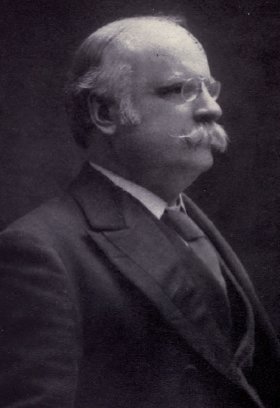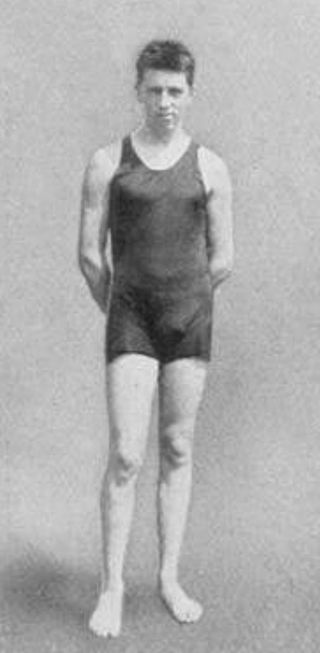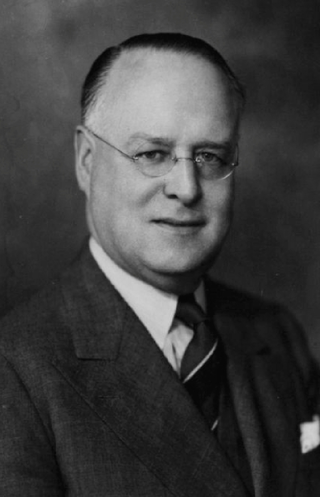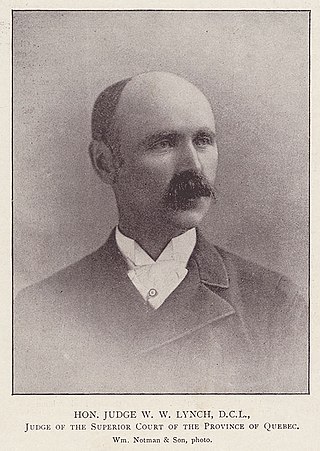Related Research Articles

Charles Joseph Doherty, was a Canadian politician, lawyer, and judge from Quebec. He served as Minister of Justice from 1911 to 1921 and was one of Canada's representatives at the Paris Peace Conference.
Lieutenant Gerald Alfred Birks was a Canadian First World War fighter ace credited with twelve aerial victories while serving in the British Royal Flying Corps and Royal Air Force.

George Ritchie Hodgson was a Canadian competition swimmer of the early 20th century, and considered by many to be the greatest swimmer in Canadian history. Hodgson won the two longer freestyle swimming gold medals at the 1912 Olympics, the only categories in which he competed. He also competed at the 1920 Summer Olympics.
William Tetley was a lawyer and professor of law at McGill University in Montreal, the visiting professor of Maritime and Commercial Law at Tulane University in New Orleans, Louisiana, and a former member of the National Assembly of Quebec and Cabinet Minister.

George Gordon Hyde was a Canadian politician and lawyer.

William Warren Lynch was a Canadian lawyer, politician, and judge in the province of Quebec.

George Washington Stephens was a Canadian politician. He became Lieutenant Colonel and President of the Saar commission of the League of Nations.

George Green Foster was a Canadian lawyer and politician.
Captain William Otway Boger was a Canadian World War I flying ace credited with five aerial victories.
Lieutenant Norman Roberts was a British World War I flying ace credited with five aerial victories.
Captain Eric Guy Brookes was a British World War I flying ace credited with six aerial victories.

Lieutenant Cleo Francis Pineau was an American World War I flying ace credited with six aerial victories. He was a renowned motorcycle racer both before and after the war. He later became an executive in the steel industry.
Captain Thomas Sydney Sharpe was a British World War I flying ace credited with six aerial victories.
Lieutenant Gavin Lynedoch Graham DFC, LdH, CdG was a South African World War I flying ace credited with thirteen confirmed aerial victories.
Captain Roy Manzer, was a Canadian World War I flying ace credited with 12 official aerial victories. After his aerial military service, he returned to Canada and a long and distinguished legal and civic career.
Captain Leonard Allan Payne was a British First World War flying ace born in Swaziland. He was credited with 11 confirmed aerial victories while piloting a Bristol F.2 Fighter.
Captain Harold Anthony Oaks (1896-1968) was a Canadian-born World War I flying ace credited with 11 confirmed aerial victories. Upon his return to Canada, his extensive pioneering activities as an aviator/geologist earned him enshrinement in the Canadian Aviation Hall of Fame.
Lieutenant Malcolm Plaw MacLeod (1897-1960) was a Canadian flying ace. He was credited with seven aerial victories scored during the closing days of World War I. He then returned to Canada to complete his education and work as a stockbroker until World War II, when he served in the Royal Canadian Air Force for the war's duration.
Merrill Samuel Taylor was a Canadian flying ace of the First World War. He was credited with seven aerial victories while flying a Sopwith Camel fighter for the Royal Naval Air Service and, later, the Royal Air Force. He touched off the air battle that resulted in the death of the war's leading ace, Manfred von Richthofen, on 21 April 1918. On 2 May 1918, he killed German ace Hans Weiss for his fifth victory. Taylor was killed in action by Franz Büchner on 7 July 1918.

The High School of Montreal was an English-language high school founded in 1843, serving Montreal, Quebec, Canada, in the area eventually known as the Golden Square Mile. It was less formally known as Montreal High School and from 1853 to 1870 was called the High School of McGill College, or the High School Division.
References
- 1 2 "Lieutenant George Buchanan Foster". Canadian Great War Project. Archived from the original on 17 August 2016. Retrieved 5 January 2012.
- ↑ The Canadian Parliamentary Guide, p. 63.
- ↑ "Alexander Buchanan". Dictionary of Canadian Biography (online ed.). University of Toronto Press. 1979–2016.
- ↑ Buchanan, Arthur William Patrick (1911). The Buchanan book. The life of Alexander Buchanan, Q.C., of Montreal, followed by an account of the family of Buchanan. pp. 152, 305–306. OL 14005714M . Retrieved 20 February 2012.
- ↑ "No. 30366". The London Gazette (Supplement). 3 November 1917. p. 11417.
- ↑ Above the Trenches, pp. 158–159.
- ↑ "No. 30989". The London Gazette (Supplement). 2 November 1918. p. 12965.
- ↑ "Old McGill Yearbook, 1921, p 49". Archived from the original on 26 May 2024. Retrieved 17 January 2020.
- ↑ "No. 37633". The London Gazette (Supplement). 1 July 1946. p. 3345.